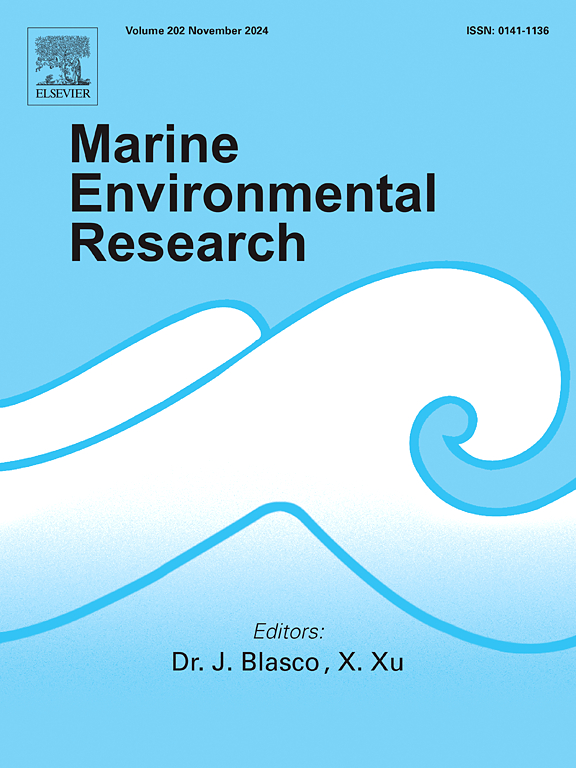Toxic effects and transcriptome analysis of the early life stages of Larimichthys crocea exposed to the bloom-forming dinoflagellate Alexandrium tamarense
IF 3
3区 环境科学与生态学
Q2 ENVIRONMENTAL SCIENCES
引用次数: 0
Abstract
This study investigated the effects of the bloom-forming dinoflagellate Alexandrium tamarense and its potentially associated paralytic shellfish toxins on the early life stages of Larimichthys crocea (large yellow croaker) by integrating physiological effects with transcriptomic analysis to explore the molecular mechanisms underlying these harmful impacts. The results showed that 48-h acute exposure to A. tamarense culture and cell-free filtrate significantly reduced the heart rate in embryos and increased mortality rates in both embryos and larvae. Transcriptome sequencing of the filtrate-exposed group identified 130 differentially expressed genes in the embryo group and 884 in the juvenile group. Further analysis revealed that algal exposure triggered the activation of innate immunity in embryos, as evidenced by the significant upregulation of immune-related cytokines such as CCL20, IL11, and ILRA10. These genes were enriched in the cytokine-cytokine receptor interaction pathway and may induce immune responses through their respective downstream pathways. Additionally, the downregulation of the RNA polymerase and ribosome pathways suggests that protein synthesis was affected during the embryo stress response induced by A. tamarense. In juveniles, genes related to cardiac function, particularly those associated with myocardial contraction and calcium ion regulation, were downregulated after exposure to algal filtrate, further suggesting that A. tamarense, possibly through paralytic shellfish toxins, inhibits the heart function of L. crocea. The findings of this study elucidate the toxicological mechanisms of A. tamarense on the early life stages of L. crocea, providing scientific evidence for the impact of harmful algal blooms on marine life health and offering valuable insights for management strategies in aquaculture.
暴露于形成开花的鞭毛藻tamarense Alexandrium的crocea早期生命阶段的毒性效应和转录组分析
本研究利用生理效应和转录组学分析相结合的方法,研究了形成藻华的甲藻亚历山大藻(Alexandrium tamarense)及其可能相关的麻痹性贝类毒素对大黄鱼(Larimichthys crocea)早期生命阶段的影响,探讨了这些有害影响的分子机制。结果表明,tamarense培养物和无细胞滤液急性暴露48 h可显著降低胚胎心率,增加胚胎和幼虫死亡率。对滤液暴露组的转录组测序发现,胚胎组有130个差异表达基因,幼鱼组有884个差异表达基因。进一步的分析表明,藻类暴露触发了胚胎先天免疫的激活,免疫相关细胞因子如CCL20、IL11和ILRA10的显著上调证明了这一点。这些基因在细胞因子-细胞因子受体相互作用途径中富集,并可能通过各自的下游途径诱导免疫应答。此外,RNA聚合酶和核糖体途径的下调表明,在tamarense诱导的胚胎应激反应中,蛋白质合成受到了影响。在幼体中,与心脏功能相关的基因,特别是与心肌收缩和钙离子调节相关的基因,在暴露于藻滤液后下调,进一步表明tamarense可能通过麻痹性贝类毒素抑制了L. crocea的心脏功能。本研究结果阐明了tamarense对crocea早期生命阶段的毒理学机制,为有害藻华对海洋生物健康的影响提供了科学依据,并为水产养殖管理策略提供了有价值的见解。
本文章由计算机程序翻译,如有差异,请以英文原文为准。
求助全文
约1分钟内获得全文
求助全文
来源期刊

Marine environmental research
环境科学-毒理学
CiteScore
5.90
自引率
3.00%
发文量
217
审稿时长
46 days
期刊介绍:
Marine Environmental Research publishes original research papers on chemical, physical, and biological interactions in the oceans and coastal waters. The journal serves as a forum for new information on biology, chemistry, and toxicology and syntheses that advance understanding of marine environmental processes.
Submission of multidisciplinary studies is encouraged. Studies that utilize experimental approaches to clarify the roles of anthropogenic and natural causes of changes in marine ecosystems are especially welcome, as are those studies that represent new developments of a theoretical or conceptual aspect of marine science. All papers published in this journal are reviewed by qualified peers prior to acceptance and publication. Examples of topics considered to be appropriate for the journal include, but are not limited to, the following:
– The extent, persistence, and consequences of change and the recovery from such change in natural marine systems
– The biochemical, physiological, and ecological consequences of contaminants to marine organisms and ecosystems
– The biogeochemistry of naturally occurring and anthropogenic substances
– Models that describe and predict the above processes
– Monitoring studies, to the extent that their results provide new information on functional processes
– Methodological papers describing improved quantitative techniques for the marine sciences.
 求助内容:
求助内容: 应助结果提醒方式:
应助结果提醒方式:


